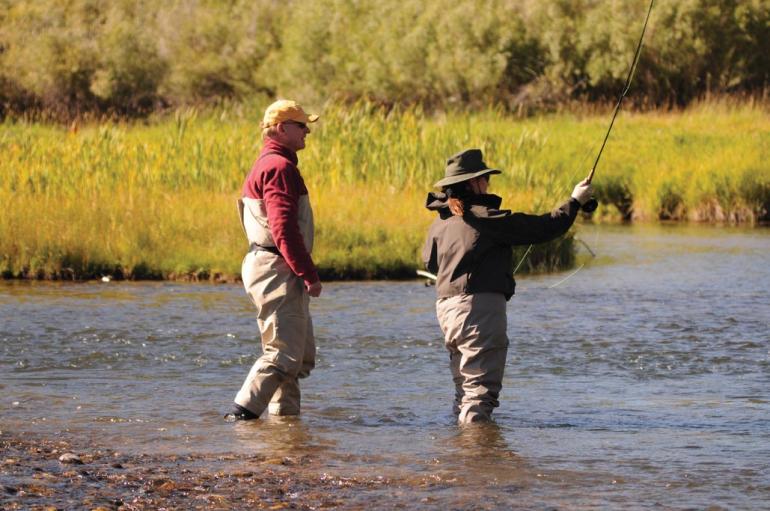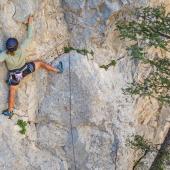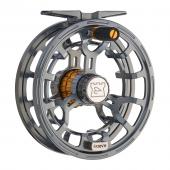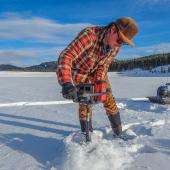Fly Fishing 101
With gear-bedecked fishermen floating and wading our rivers all summer long, it’s clear that fly fishing has become one of the most popular activities in southwest Montana. And for good reason: it’s exciting, rewarding, and relaxing, and it allows you to spend quality time outdoors. Amazingly, some of you still haven’t tried it yet! We know, there’s tons of gear, lingo, and technique—not to mention the high-minded attitude—associated with fly fishing, and it all looks so difficult and intimidating. Fear not, intrepid flyfisher-to-be—we’ve put together a guide to get you started. Now you can get out there, join the crowd, and see what all the fuss is about.
The Gear
Just like any other kind of fishing, your basic set-up involves a rod, reel, line, and lures. The “lures” in this case (FYI: don’t let your fly fishing buddies hear you use that term) are artificial flies, designed to imitate the bugs that trout, whitefish, and other Bozeman-area fish eat. Presenting that tiny fly on the water, in a somewhat realistic manner, is where fly fishing’s specialized equipment and technique come in.
The rod is how you’ll deliver your line, and the fly attached to it, to your unsuspecting quarry. There are many lengths, weights, actions, and brands. The most common for our area is a nine-foot five-weight with a medium to fast action. This configuration is long enough to cast a good distance, strong enough to haul in a hefty fish, and flexible enough at the tip to make casting relatively easy.
The reel holds your fly line; there’s a handle to reel it in (hence the name) and a drag control to adjust tension on the spool, varying how easily the line can be stripped off either by you or a fish. Fly reels are typically manual, single-action designs which retrieve the line at a 1:1 ratio, meaning one revolution of the handle equals one revolution of the spool. Larger “arbor” reels allow you to retrieve your line faster.
The line comprises three parts: backing, fly line, and leader. The backing is your reserve line (usually braided nylon) for when a big fish takes off downstream. Next comes the actual fly line, which is typically yellow, green, or some other high-visibility color. Most people use a floating, weight-forward fly line; being heavier toward the front makes it easier to cast. The leader is a clear monofilament (like most spin-fishing rigs use) that has a long taper and is your conduit from line to fly. Most leaders run from seven to nine feet in length and come in different weights (3x, 4x, 5x, etc.), which translates into breaking strength—the smaller the number, the stronger it is. For dry fly fishing, a nine-foot 6x is a good all-purpose leader. Tippet—another, lighter section of monofilament used to extend the leader—comes in small spools by weight. When tying tippet to your leader, always go from a thicker line (smaller number) to a thinner line (larger number) to avoid tangles when casting.
Flies come in all sizes and shapes; they imitate every bug you can think of, from gigantic grasshoppers to miniscule midges and everything in between. Dry flies are fished at the surface and imitate winged insects landing on the water from above; nymphs represent the immature larva stage of the bug as it moves through metamorphosis. Streamers typically mimic minnows, leeches, crayfish, and other large critters that live underwater. Fly sizes generally run from #4 or #6 (large) down to #20 or #22 (tiny). Ask the folks at your local fly or outdoor shop to set you up with a couple dozen standard patterns—both dry and wet—and don’t go too small too soon.
You’ll need a good vest or pack to store all your flies, tippet, and other items. Accoutrements pile up quickly in this sport, so the more pockets, the better. The key factor is convenience—you don’t want to wade to the bank and remove your pack every time you need to tie on a new fly.
Waders range from lightweight and breathable fabrics to warm and durable neoprene, with or without attached wading boots. Remember your wading belt in case you tip over—it keeps the waders from filling up and making you sink. The whole goal is to stay dry and have fun. However, as the water warms in July and August, feel free to leave the waders at home and wet-wade in a pair of shorts if you so desire.
Technique
With spin fishing, the weighted lure or sinker on the end is what actually carries the line. Fly fishing differs in that because a fly has no weight, you’re actually casting the line, not the lure. A longer rod, specialized line, and a specific back-and-forth casting technique allow you to move increasing amounts of line out toward your target, eventually dropping it to the water and letting your fly tempt a hungry trout.
You’ve probably heard about the “10-and-2” casting routine, which refers to clock position. Start with 10-12 feet of line played out on the ground in front of you and the rod pointed forward in the 2:00 position. Flick the line up and back, stopping your arm when the rod is at 10:00. Allow the line to almost straighten out behind you and “load” the rod with its weight. Then bring the rod forward, stopping at 2:00 again and letting the line continue forward the same way. Repeat this motion until you’ve got a good rhythm, with the line straightening out each time in a single fluid movement. Keep doing this, gradually feeding more line until you can reach out a good 20-25 feet in front. Then, on your next forward motion, keep your rod in the 2:00 position and let the line fall. The line should roll out and drop the fly in a natural motion, not make a big splash.
Remember that casting is the hardest part of fly fishing. Be patient, keep at it, and eventually it will all come together. Watch your line, and don’t bring your rod forward prematurely. The idea is to lay the line out, and that won’t happen if you pull forward too soon. Before heading out to the river, it’s a good idea to practice in the back yard. Patience plummets as fish start to rise on the river.
Where to Go
The East and West Gallatin rivers are great bodies of water to get started on. They’re close to town, have plenty of access points, and are large enough to support many anglers at one time. Find a spot with plenty of room behind you for your back cast—there’s no faster route to frustration than snagging your fly in a tree every time you cast. You can also get started on a pond or lake—try the East Gallatin Pond, the Cherry River Ponds, or Hyalite Reservoir—as the banks are often devoid of trees, and you don’t have to worry about dealing with the current (yet another point on the learning curve) on your first day out.
What to Use
With the exception of presentation, flies are arguably the most important part of fly fishing, and your best bet is to talk to an experienced fisherman to find out what pattern the trout like. There are a few that you should always keep in your “quiver” for use anywhere and under all conditions. For nymphs, these include the Red Copper John, Prince Nymph, Gold-Ribbed Hare’s Ear, and San Juan Worm. For dry flies, try Elk Hair Caddis, Royal Wulff, Royal Stimulator, Adams, and Dave’s Hoppers. For streamers, use Woolly Buggers, Olive Zonkers, and leech patterns. If you’re fishing with nymphs or streamers, a good strike indicator is also recommended; these work similar to a bobber (again, don’t actually call it that around other fly fishermen) and help you notice when the fish are taking your fly.
Etiquette & Ethics
Don’t forget to buy a fishing license and keep it on you. Check the Montana Fish, Wildlife & Parks regulations for the areas you plan on fishing.
If you encounter other anglers on the water, be courteous and give them room. There’s plenty of water, so take advantage of the solitude.
When you leave a body of water, make sure you have gathered all your trash and rinsed your boat, waders, boots, and other gear completely to remove any invasive species that may try to hitch a ride to another body of water with you.
Be careful with the fish you land. Keep the smaller ones for dinner and release the larger ones to fight another day. When releasing fish, keep the net in the water, handle the fish with wet hands, use hemostats (surgical pliers) to remove the fly, and release the fish quickly. If you want to take a photo of your trophy, hold the fish out of the water for only a few seconds. If your friend is fumbling with the camera, put the fish back into the water until he gets his act together.
Resources
Your absolute best resources are the local fly shops and outdoor stores with fishing departments, which can help set you up with gear and advice. You’ll find plenty of magazines devoted to fly fishing there, as well as guidebooks to our region; they can also turn you on to useful websites and blogs. Not to mention the dozens of books on casting, fly tying, technique, and every other fly fishing subject you can think of. Stop by your favorite shop and get yourself hooked up—you may just discover a new hobby, one you can enjoy for the rest of your days.
Elissa Stagg has a passion for fishing, and works with the Bob Ward anglers (and their 40 years of combined experience) to help get new fly fishers out on the water.











